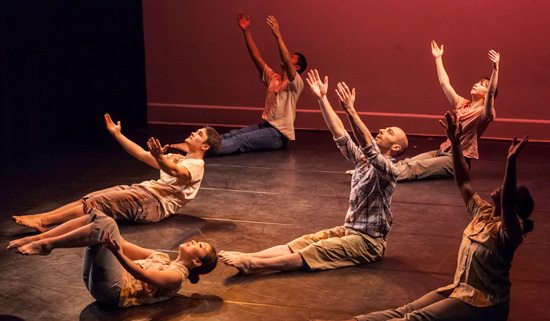
 H.T. Chen and Dancers presented the New York premiere of South of Gold Mountain, October 15-18 at New York Live Arts. The dance documentary uses audio recordings, projected historical photographs, and Chinese and Delta blues music to accompany a contemporary modern dance choreographed by H.T. Chen and Dian Dong. The work follows the chronology of Chinese immigrants from their motherland to the deep South—a land of segregation, prejudice, and poverty. With stories of determination, hard work, resilience, and perseverance, it is a true and timeless American immigrant story.
H.T. Chen and Dancers presented the New York premiere of South of Gold Mountain, October 15-18 at New York Live Arts. The dance documentary uses audio recordings, projected historical photographs, and Chinese and Delta blues music to accompany a contemporary modern dance choreographed by H.T. Chen and Dian Dong. The work follows the chronology of Chinese immigrants from their motherland to the deep South—a land of segregation, prejudice, and poverty. With stories of determination, hard work, resilience, and perseverance, it is a true and timeless American immigrant story.
The first sections of the piece create a sense of impermanence for the characters; it is not until the section Fresh Sprouts that we see them both literally and metaphorically planting seeds in their new-found home. The movement begins with pantomimed planting motions with the hands. They are grounded, stable, and strong, not giving in to the wearisome work, but rather focusing outward onto the harvest to come when they can see the fruits of their labor.
Another section, Box Dance, is perhaps the most eloquent choreographic metaphor for the way in which families carried a weight for their future generations. Historic photographs provide a backdrop for the dancers as they struggle to lift imaginary boxes. In their bodies you can see the effort, a heavy and weighted quality. And yet, the dance also features beautifully executed partnering with a rather light quality. We can see that the work is hard, but when it comes to providing for loved ones, one can and will do anything—no matter the weight.
Family Laundry features both elders and young children, selected from The School at the Chen Dance Center. Dian Dong (Associate Director) and Renouard Gee dance as the elders—the two have been dancing together for 28 years. The piece begins with packages of laundry flying onto the stage from the wings, appearing to come out of nowhere. There is a feeling of impatience as the packages land, slapping against the stage, one after the other. Yet the gentleness with which Dong, Gee, and children dance contrasts with this outside world of demand. The children's movement gradually develops into an innocent playfulness that is joyful, but perhaps also a cause for concern—will the young sprouts ever be able to understand the sacrifice that was made for them?
During the post-performance discussion on Friday night, a little boy asked about the people in the photos and where the photos came from. The performance couldn’t have incited a better question. It’s purpose, after all, is to speak a true history of a heritage that has existed, up until now, mostly in silence. South of Gold Mountain prompts us all to look into our own heritage, to reach out to our elders, and to ask not only the question of “who are they?” but also the question, “who am I?” And by getting a close-up look at this particular piece of history, H.T. Chen & Dancers promote empathy, tolerance, and understanding for others who have a similar story.